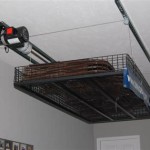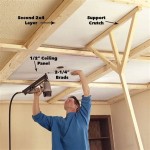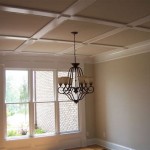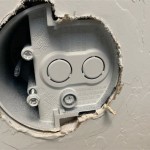Insulating Your Basement Ceiling: A Comprehensive Guide
Insulating a basement ceiling represents a strategic investment in home comfort, energy efficiency, and overall property value. Uninsulated basement ceilings contribute significantly to heat loss in the winter and can lead to uncomfortable humidity levels in the summer. This article offers a detailed exploration of the process, materials, and benefits associated with insulating a basement ceiling.
The basement, often located partially or entirely below ground level, is subject to unique environmental conditions. Ground temperature often remains relatively stable, which can moderate temperature fluctuations within the basement. However, uninsulated basement ceilings allow for significant heat transfer between the conditioned living spaces above and the basement below. This leads to higher energy bills and an uneven distribution of temperature throughout the home. Effective insulation minimizes this heat transfer, creating a more comfortable and energy-efficient living environment.
Before undertaking any insulation project, a thorough assessment of the existing basement conditions is crucial. This includes identifying any sources of moisture, such as leaks or condensation, and addressing them before installing insulation. Moisture can compromise the effectiveness of insulation materials and potentially lead to mold growth, which poses health and structural risks.
Key Considerations Before Insulating Your Basement Ceiling
Several factors must be carefully considered prior to commencing the insulation process. These considerations encompass structural integrity, building codes, budget constraints, and the intended use of the basement space.
Assessing Structural Integrity: The structural integrity of the basement ceiling must be evaluated before adding any weight, including insulation materials. Examine the joists and subflooring for signs of rot, water damage, or insect infestation. Addressing structural issues before installing insulation will prevent potential problems in the future. In some cases, reinforcing the existing structure might be necessary to support the added weight of the insulation.
Understanding Local Building Codes: Local building codes often dictate the type and amount of insulation required for basement ceilings. These codes are designed to ensure energy efficiency and safety. Contact the local building department to obtain information regarding specific requirements for basement insulation in your area. Failure to comply with building codes can result in fines and necessitate the removal of improperly installed insulation.
Establishing a Realistic Budget: Insulating a basement ceiling involves material costs, labor expenses (if hiring a professional), and potential costs associated with addressing moisture issues or structural repairs. Develop a realistic budget that accounts for all these factors. Obtaining multiple quotes from contractors can help ensure competitive pricing and allow for informed decision-making.
Determining the Intended Use of the Basement: The intended use of the basement space will influence the choice of insulation materials and the level of insulation required. A finished basement used as a living area will require different insulation considerations than an unfinished basement primarily used for storage. For finished basements, aesthetic considerations and fire safety become more important factors.
Types of Insulation Materials for Basement Ceilings
A variety of insulation materials are suitable for use in basement ceilings, each possessing unique properties and advantages. The selection of the appropriate material depends on budget, desired R-value (a measure of thermal resistance), ease of installation, and specific project requirements.
Fiberglass Insulation: Fiberglass insulation, available in batts and rolls, is a widely used and relatively inexpensive option. It's composed of spun glass fibers and offers good thermal performance. Fiberglass is easy to install between joists, but it's essential to wear protective gear (gloves, mask, and eye protection) during installation, as the fibers can be irritating to the skin and respiratory system. While cost-effective, fiberglass insulation can lose its effectiveness if it becomes wet or compressed. It also requires a vapor barrier in some climates to prevent moisture buildup.
Mineral Wool Insulation: Mineral wool, also known as rock wool or slag wool, is made from recycled materials and offers excellent thermal and acoustic insulation properties. Similar to fiberglass, it's available in batts and rolls and is installed between joists. Mineral wool is more resistant to fire and moisture than fiberglass. It's also denser, providing better soundproofing capabilities. However, it is typically more expensive than fiberglass insulation.
Spray Foam Insulation: Spray foam insulation provides a superior air seal, minimizing air leakage and maximizing energy efficiency. It expands to fill gaps and crevices, creating a tight barrier against drafts and moisture. There are two main types of spray foam: open-cell and closed-cell. Closed-cell spray foam offers a higher R-value per inch and is more resistant to moisture, making it a suitable choice for basements. Open-cell spray foam is less expensive but offers a lower R-value and less moisture resistance. Spray foam insulation requires professional installation due to the specialized equipment and expertise required.
Rigid Foam Board Insulation: Rigid foam boards, such as extruded polystyrene (XPS), expanded polystyrene (EPS), and polyisocyanurate (polyiso), are another option for insulating basement ceilings. These boards are typically attached directly to the underside of the ceiling joists. Rigid foam boards offer good thermal resistance and are relatively moisture-resistant. They can be cut to size and easily installed. However, it's crucial to seal the seams between the boards to prevent air leakage. Covering the rigid foam board with a fire-rated material, such as drywall, is often required to meet building codes.
Radiant Barrier Insulation: Radiant barrier insulation reflects radiant heat away from the ceiling, which can be particularly beneficial in warmer climates. It typically consists of a reflective material, such as aluminum foil, laminated to a backing material. Radiant barriers are most effective when there is an air space between the reflective surface and the ceiling. They can be used in conjunction with other types of insulation to enhance overall thermal performance. However, their effectiveness is limited in colder climates, where conductive heat transfer is more dominant.
The Insulation Installation Process
The installation process varies depending on the type of insulation material selected. However, generally, the following steps outline the basic procedures involved in insulating a basement ceiling.
Preparation: Before starting the installation process, clean the basement ceiling area thoroughly. Remove any debris, cobwebs, or loose materials. Address any moisture problems and ensure the area is dry. Gather all necessary tools and materials, including insulation, a utility knife, measuring tape, safety glasses, gloves, and a dust mask.
Cutting and Fitting: Measure the spaces between the joists of the basement ceiling. Cut the insulation material (batts, rolls, or rigid foam boards) to the appropriate size, allowing for a snug fit. For fiberglass or mineral wool batts, ensure they are not compressed, as compression reduces their insulating value. For rigid foam boards, use a sharp utility knife to cut them to the required dimensions.
Installing the Insulation: Install the insulation between the joists, ensuring it fits snugly without gaps. For fiberglass or mineral wool batts, friction fit is typically sufficient to hold them in place. Consider using wire supports or insulation hangers to provide additional support and prevent sagging over time. For rigid foam boards, attach them directly to the underside of the joists using construction adhesive and/or fasteners. Ensure all seams are properly sealed with foil tape or caulk to prevent air leakage.
Vapor Barrier (if required): In some climates, a vapor barrier is necessary to prevent moisture from migrating into the insulation. The vapor barrier should be installed on the warm side of the insulation (typically the side facing the conditioned living space above). Polyethylene sheeting is commonly used as a vapor barrier. Overlap the seams and seal them with tape to create a continuous barrier.
Finishing (if applicable): If finishing the basement ceiling, cover the insulation with drywall or another appropriate material. Drywall provides a fire-resistant barrier and creates a finished look. Ensure the drywall is properly installed and that all seams are taped and mudded to create a smooth surface. Prime and paint the drywall to complete the project.
Professional Installation: For some insulation materials, such as spray foam, professional installation is highly recommended. Professional installers have the necessary equipment and expertise to ensure proper application and maximize the insulation's performance. Hiring a professional can also save time and effort and provide peace of mind that the job is done correctly.
Benefits of Insulating Your Basement Ceiling
Insulating a basement ceiling offers numerous benefits, contributing to a more comfortable, energy-efficient, and valuable home.
Reduced Energy Bills: Insulating the basement ceiling significantly reduces heat transfer between the basement and the living spaces above, leading to lower heating and cooling costs. The reduced energy consumption translates into substantial savings on utility bills over the long term.
Increased Comfort: Insulating the basement ceiling helps maintain a more consistent and comfortable temperature throughout the home. It eliminates cold floors in the living spaces above and reduces drafts, creating a more pleasant indoor environment.
Improved Air Quality: By reducing air leakage, basement ceiling insulation can improve indoor air quality. It helps prevent allergens, dust, and pollutants from entering the living spaces from the basement.
Noise Reduction: Insulation materials, particularly mineral wool and spray foam, provide soundproofing benefits. Insulating the basement ceiling can reduce noise transmission between the basement and the living spaces above, creating a quieter and more peaceful home environment.
Increased Home Value: Insulating a basement ceiling adds value to the home by improving its energy efficiency and comfort. It's a beneficial improvement for future buyers and can be a selling point when listing the property.
Moisture Control: Proper insulation, coupled with a vapor barrier (if required), helps control moisture levels in the basement. It prevents condensation and mold growth, protecting the structural integrity of the home and promoting a healthier indoor environment.
By understanding the process, materials, and benefits associated with insulating a basement ceiling, homeowners can make informed decisions and create a more comfortable, energy-efficient, and valuable living space.

How To Finish A Basement Diy

Air Sealed Insulated Basements Building America Solution Center

Keeping The Heat In Section 6 Basement Insulation Floors Walls And Crawl Spaces Natural Resources

How To Insulate Basement With Spray Foam Insulation 2024

Air Sealing And Insulating Ceilings In Vented Attics Building America Solution Center

How To Install Ceiling Insulation In A Basement Or Crawlspace Why You Should R30 R21 R19 R13

What S The Best Way To Insulate A Basement Slab Greenbuildingadvisor

Finishing A Basement Step By Guide Neighbor Blog

Air Sealing And Insulating Ceilings In Vented Attics Building America Solution Center

How To Insulate A Crawl Space
Related Posts








